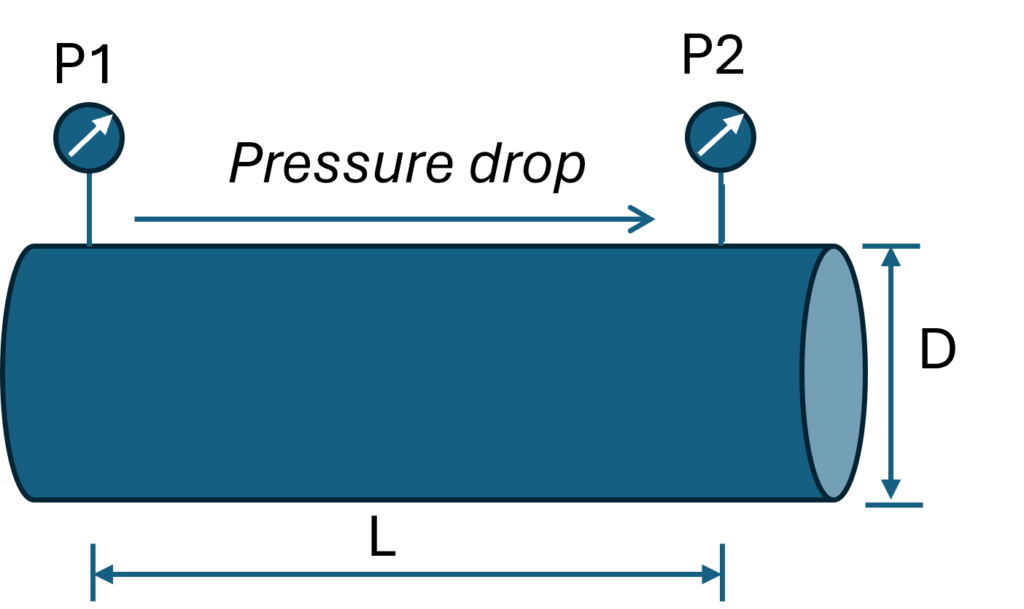Pressure Drop Calculator
Calculate pressure drop, fluid velocity and Reynolds number
Equations
Velocity of Fluid
Velocity is calculated using the continuity equation:
\[ V = \frac{Q}{\frac{\pi D^2}{4}} \]
Reynolds Number
Reynolds number determines the flow regime:
\[ Re = \frac{\rho V D}{\mu} \]
Friction Factor
Calculated using the empirical Colebrook equation:
\[ f = \left( \frac{1}{-3.6 \log_{10} \left( \left( \frac{\varepsilon}{3.7D} \right)^{1.11} + \frac{6.9}{Re} \right) } \right)^2 \]
Pressure Drop
Pressure drop is calculated using the Darcy-Weisbach equation:
\[ \Delta P = f \left( \frac{L}{D/2} \right) \rho V^2 \]
📖 Variables Legend
| Variable | Description | Unit |
|---|---|---|
| \( Q \) | Flow rate | \( m^3/s \) |
| \( V \) | Velocity | \( m/s \) |
| \( D \) | Pipe Diameter | \( m \) |
| \( \rho \) | Density of Fluid | \( kg/m^3 \) |
| \( \mu \) | Dynamic Viscosity | \( Pa \cdot s \) |
| \( f \) | Friction Factor | - |
| \( \varepsilon \) | Pipe Roughness | \( m \) |
| \( L \) | Pipe Length | \( m \) |
| \( \Delta P \) | Pressure Drop | \( Pa \) |
What is pressure drop of a flowing fluid?

The pressure drop of a fluid in a pipe is the reduction in pressure as fluid flows from one end of the pipe to the other.
This drop occurs due to friction between the fluid and the inner surface of the pipe, as well as due to any bends, fittings, or changes in pipe diameter that cause resistance to flow.
Mathematically, pressure drop (ΔP) is the difference between the inlet pressure (P1) and the outlet pressure (P2) of the fluid along the pipe length.
Why it's important to calculate pressure drop?
System Efficiency: Excessive pressure drop means more energy is required to pump the fluid through the pipe. Calculating and minimizing pressure drop can improve system efficiency and reduce operational costs.
Proper Equipment Sizing: Accurate pressure drop calculations are essential for selecting the right pump size. Underestimating pressure drop could lead to undersized equipment, which may not achieve the desired flow rate, while overestimating can result in unnecessary energy consumption.
Avoiding System Issues: High pressure drops can lead to issues like cavitation, especially in long pipelines, and can affect the performance and longevity of equipment.
Safety: In industrial settings, maintaining appropriate pressure is critical for safe operation, especially in systems that handle high-pressure fluids or hazardous substances.
Factors Affecting Pressure Drop
The main factors affection the pressure drop are:
- Pipe diameter (D): Smaller pipes cause higher pressure drops.
- Pipe length (L): Longer pipes create more resistance to flow.
- Fluid velocity (V): Higher velocity increases friction losses.
- Fluid viscosity (μ): More viscous fluids experience greater resistance.
- Pipe roughness (ε): Rougher surfaces cause turbulence and increase losses.
How to Reduce Pressure Drop in a System
Practical ways to optimize a system and reduce energy losses:
- Use larger diameter pipes to decrease resistance.
- Reduce the number of bends and fittings in the pipeline.
- Choose smooth pipes to minimize turbulence.
- Ensure the pumps and compressors are correctly sized.
- Maintain clean pipes (scale buildup can increase roughness).
Pressure Drop and Energy Efficiency
Pressure drop has a direct relationship with energy consumption and costs as:
- Higher pressure drop = higher pump energy requirements = more electricity cost.
- Efficient pipe design can reduce operating costs in industrial plants.
- Optimizing pressure drop improves overall system longevity and performance.
Common Mistakes in Pressure Drop Calculations
Avoid calculation errors such as:
- Ignoring minor losses from fittings, valves, and bends.
- Using incorrect fluid properties (density, viscosity) at operating conditions.
- Forgetting to check flow regime (laminar/turbulent).
- Not considering temperature effects on fluid properties.
© 2025 HowICalculate.com